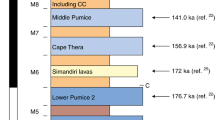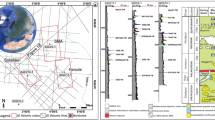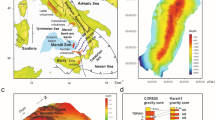Abstract
Catastrophic, caldera-forming explosive eruptions generate hazardous ash fall, pyroclastic density currents and, in some cases, tsunamis, yet their dynamics are still poorly understood. Here we use scaled analogue experiments and spectral analysis of well-preserved concentric terracing of seafloor deposits built by submarine caldera-forming explosive eruptions to provide insights into the dynamics governing these eruptions and the resultant hazards. We show that powerful submarine eruption columns in collapsing regimes deliver material to the sea surface and seabed in periodic annular sedimentation waves. Depending on the period between successive waves, which becomes shorter with decreasing jet strength, their impact and spread at the sea surface and/or seabed can excite tsunamis, drive radial pyroclastic density currents and build concentric terraces with a wavelength that decreases with distance, or deposits that thin monotonically. Whereas the Sumisu (Izu–Bonin arc) caldera deposit architecture is explained by either a subaerial or deep-water model involving no interaction between sedimentation waves and the sea surface, those of the Macauley (Kermadec arc) and Santorini (Hellenic arc) calderas are consistent with a shallow-water model with extensive sedimentation wave–sea surface–seabed interactions. Our findings enable an explicit classification of submarine caldera-forming explosive eruption dynamics and quantitative estimates of eruption rates from their terraced deposits.
This is a preview of subscription content, access via your institution
Access options
Access Nature and 54 other Nature Portfolio journals
Get Nature+, our best-value online-access subscription
$29.99 / 30 days
cancel any time
Subscribe to this journal
Receive 12 print issues and online access
$259.00 per year
only $21.58 per issue
Buy this article
- Purchase on Springer Link
- Instant access to full article PDF
Prices may be subject to local taxes which are calculated during checkout






Similar content being viewed by others
Data availability
Source parameter data for experiments conducted in this study are presented in Table 1. Data for Figs. 2, 3 and 4 are available at https://doi.org/10.6084/m9.figshare.c.6432137.v1. Santorini bathymetry data are available at https://doi.org/10.7284/119607 and https://doi.org/10.7284/906516.
Code availability
Code used for spectral analysis of fountain-top height oscillations and deposit profiles are available upon email request: jgilchri@eoas.ubc.ca.
References
Rampino, M. R. & Self, S. Volcanic winter and accelerated glaciation following the Toba super-eruption. Nature 359, 50–52 (1992).
Robock, A. et al. Did the Toba volcanic eruption of ~74 ka bp produce widespread glaciation? J. Geophys. Res. Atmos. https://doi.org/10.1029/2008JD011652 (2009).
Williams, M. The 73 ka Toba super-eruption and its impact: history of a debate. Quat. Int. 258, 19–29 (2012).
Raible, C. C. et al. Tambora 1815 as a test case for high impact volcanic eruptions: Earth system effects. Wiley Interdiscip. Rev. Clim.Change 7, 569–589 (2016).
Driessen, J. The Santorini eruption. an archaeological investigation of its distal impacts on minoan crete. Quat. Int. 499, 195–204 (2019).
Druitt, T. H., McCoy, F. W. & Vougioukalakis, G. E. The late Bronze Age eruption of Santorini volcano and its impact on the ancient Mediterranean world. Elements 15, 185–190 (2019).
Black, B. A., Lamarque, J.-F., Marsh, D. R., Schmidt, A. & Bardeen, C. G. Global climate disruption and regional climate shelters after the Toba supereruption. Proc. Natl Acad. Sci. USA 118, e2013046118 (2021).
Lespez, L. et al. Discovery of a tsunami deposit from the Bronze Age Santorini eruption at Malia (Crete): impact, chronology, extension. Sci. Rep. 11, 15487 (2021).
Schmidt, A. & Black, B. A. Reckoning with the rocky relationship between eruption size and climate response: toward a volcano–climate index. Annu. Rev. Earth Planet. Sci. 50, 627–661 (2022).
Sigurdsson, H. et al. Marine investigations of Greece’s Santorini volcanic field. Eos 87, 337–342 (2006).
Tani, K. et al. Sumisu volcano, Izu–Bonin arc, Japan: site of a silicic caldera-forming eruption from a small open-ocean island. Bull. Volcanol. 70, 547–562 (2008).
Rotella, M. D., Wilson, C. J., Barker, S. J. & Wright, I. C. Highly vesicular pumice generated by buoyant detachment of magma in subaqueous volcanism. Nat. Geosci. 6, 129–132 (2013).
Pope, E. L. et al. Origin of spectacular fields of submarine sediment waves around volcanic islands. Earth Planet. Sci. Lett. 493, 12–24 (2018).
Hooft, E. E. et al. Backarc tectonism, volcanism, and mass wasting shape seafloor morphology in the Santorini–Christiana–Amorgos region of the Hellenic volcanic arc. Tectonophysics 712, 396–414 (2017).
Seabrook, S. et al. Pyroclastic density currents explain far-reaching and diverse seafloor impacts of the 2022 Hunga Tonga Hunga Ha’apai eruption. Preprint at Research Square https://doi.org/10.21203/rs.3.rs-2395332/v1 (2023).
Wynn, R. B., Weaver, P. P., Ercilla, G., Stow, D. A. & Masson, D. G. Sedimentary processes in the selvage sediment-wave field, NE Atlantic: new insights into the formation of sediment waves by turbidity currents. Sedimentology 47, 1181–1197 (2000).
Lee, H. J. et al. Distinguishing sediment waves from slope failure deposits: field examples, including the ‘Humboldt slide’, and modelling results. Mar. Geol. 192, 79–104 (2002).
Wright, I., Worthington, T. & Gamble, J. New multibeam mapping and geochemistry of the 30–35° S sector, and overview, of southern Kermadec arc volcanism. J. Volcanol. Geothermal Res. 149, 263–296 (2006).
Gilchrist, J. T. & Jellinek, A. M. Sediment waves and the gravitational stability of volcanic jets. Bull. Volcanol. 83, 64 (2021).
Kaminski, É. & Jaupart, C. Marginal stability of atmospheric eruption columns and pyroclastic flow generation. J. Geophys. Res. 106, 21785 (2001).
Carazzo, G., Kaminski, E. & Tait, S. On the dynamics of volcanic columns: a comparison of field data with a new model of negatively buoyant jets. J. Volcanol. Geothermal Res. 178, 94–103 (2008).
Jessop, D., Gilchrist, J., Jellinek, A. & Roche, O. Are eruptions from linear fissures and caldera ring dykes more likely to produce pyroclastic flows? Earth Planet. Sci. Lett. 454, 142–153 (2016).
Cahalan, R. & Dufek, J. Explosive submarine eruptions: the role of condensable gas jets in underwater eruptions. J. Geophys. Res. Solid Earth 126, e2020JB020969 (2021).
Rowell, C. R., Jellinek, A. M., Hajimirza, S. & Aubry, T. J. External surface water influence on explosive eruption dynamics, with implications for stratospheric sulfur delivery and volcano–climate feedback. Front. Earth Sci. https://doi.org/10.3389/feart.2022.788294 (2022).
Giordano, G. & Cas, R. A. Classification of ignimbrites and their eruptions. Earth Sci. Rev. 220, 103697 (2021).
Cas, R. A. & Simmons, J. M. Why deep-water eruptions are so different from subaerial eruptions. Front. Earth Sci. 6, 198 (2018).
Maeno, F. et al. Seawater–magma interactions sustained the high column during the 2021 phreatomagmatic eruption of Fukutoku-Oka-no-Ba. Commun. Earth Environ. 3, 260 (2022).
Fauria, K. E. & Manga, M. Pyroclast cooling and saturation in water. J. Volcanol. Geothermal Res. 362, 17–31 (2018).
Burridge, H. & Hunt, G. The rhythm of fountains: the length and time scales of rise height fluctuations at low and high froude numbers. J. Fluid Mech. 728, 91–119 (2013).
Ozmidov, R. V. On the turbulent exchange in a stably stratified ocean. Atmos. Ocean. Phys. 1, 853–860 (1965).
Bush, J. W., Thurber, B. & Blanchette, F. Particle clouds in homogeneous and stratified environments. J. Fluid Mech. 489, 29–54 (2003).
Self, S. & Rampino, M. R. The 1883 eruption of Krakatau. Nature 294, 699–704 (1981).
Sigurdsson, H., Carey, S., Mandeville, C. & Bronto, S. Pyroclastic flows of the 1883 Krakatau eruption. Eos 72, 377–381 (1991).
Terry, J. P., Goff, J., Winspear, N., Bongolan, V. P. & Fisher, S. Tonga volcanic eruption and tsunami, January 2022: globally the most significant opportunity to observe an explosive and tsunamigenic submarine eruption since ad 1883 Krakatau. Geosci. Lett. 9, 24 (2022).
Costa, A., J Suzuki, Y. & Koyaguchi, T. Understanding the plume dynamics of explosive super-eruptions. Nat. Commun. 9, 654 (2018).
Aubry, T. J. et al. The independent volcanic eruption source parameter archive (IVESPA, version 1.0): a new observational database to support explosive eruptive column model validation and development. J. Volcanol. Geothermal Res. 417, 107295 (2021).
Hall, B., Meiburg, E. & Kneller, B. Channel formation by turbidity currents: Navier–Stokes-based linear stability analysis. J. Fluid Mech. 615, 185–210 (2008).
Cartigny, M. J., Ventra, D., Postma, G. & van Den Berg, J. H. Morphodynamics and sedimentary structures of bedforms under supercritical-flow conditions: new insights from flume experiments. Sedimentology 61, 712–748 (2014).
Kieffer, S. W., Meiburg, E., Best, J. & Austin, J. The mysterious grooves of Volcán Bárcena: a review of the role of streamwise counter-rotating vortices during erosion by dilute pyroclastic density currents. Bull. Volcanol. 83, 26 (2021).
Dufek, J. & Bergantz, G. W. Dynamics and deposits generated by the Kos Plateau Tuff eruption: controls of basal particle loss on pyroclastic flow transport. Geochem. Geophys. Geosysyt. https://doi.org/10.1029/2007GC001741 (2007).
Rowley, P. D., Macleod, N. S., Kuntz, M. A. & Kaplan, A. M. Proximal bedded deposits related to pyroclastic flows of May 18, 1980, Mount St. Helens, Washington. Geol. Soc. Am. Bull. 90, 2929–2947 (1985).
Roche, O., Buesch, D. C. & Valentine, G. A. Slow-moving and far-travelled dense pyroclastic flows during the Peach Spring super-eruption. Nat. Commun. 7, 10890 (2016).
Lube, G., Breard, E. C., Esposti-Ongaro, T., Dufek, J. & Brand, B. Multiphase flow behaviour and hazard prediction of pyroclastic density currents. Nat. Rev. Earth Environ. 1, 348–365 (2020).
Gilchrist, J. T., Jellinek, A. M. & Hooft, E. Submarine terraced deposits linked to periodic collapse of caldera-forming eruption columns (Version 1). Figshare https://doi.org/10.6084/m9.figshare.c.6432137.v1 (2023).
Lherm, V. & Jellinek, A. Experimental constraints on the distinct effects of ash, lapilli, and larger pyroclasts on entrainment and mixing in volcanic plumes. Bull. Volcanol. 81, 73 (2019).
Fischer, H. B., List, J. E., Koh, R. C. Y., Imberger, J. & Brooks, N. H. Mixing in inland and coastal waters (Academic Press, 1979).
Carazzo, G. & Jellinek, A. M. A new view of the dynamics, stability and longevity of volcanic clouds. Earth Planet. Sci. Lett. 325, 39–51 (2012).
Hunt, G. & Burridge, H. Fountains in industry and nature. Annu. Rev. Fluid Mech. 47, 195–220 (2015).
Woods, A. W. Turbulent plumes in nature. Annu. Rev. Fluid Mech. 42, 391–412 (2010).
Glaze, L. S. & Baloga, S. M. Sensitivity of buoyant plume heights to ambient atmospheric conditions: implications for volcanic eruption columns. J. Geophys. Res. Atmos. 101, 1529–1540 (1996).
Aubry, T. J. & Jellinek, A. M. New insights on entrainment and condensation in volcanic plumes: constraints from independent observations of explosive eruptions and implications for assessing their impacts. Earth Planet. Sci. Lett. 490, 132–142 (2018).
Eaton, J. K. & Fessler, J. Preferential concentration of particles by turbulence. Int. J. Multiph. Flow 20, 169–209 (1994).
Elghobashi, S. On predicting particle-laden turbulent flows. Appl. Sci. Res. 52, 309–329 (1994).
Burgisser, A., Bergantz, G. W. & Breidenthal, R. E. Addressing complexity in laboratory experiments: the scaling of dilute multiphase flows in magmatic systems. J. Volcanol. Geothermal Res. 141, 245–265 (2005).
Morton, B., Taylor, G. I. & Turner, J. S. Turbulent gravitational convection from maintained and instantaneous sources. Proc. R. Soc. Lond. A 234, 1–23 (1956).
Bloomfield, L. J. & Kerr, R. C. Turbulent fountains in a stratified fluid. J. Fluid Mech. 358, 335–356 (1998).
Bloomfield, L. J. & Kerr, R. C. Turbulent fountains in a confined stratified environment. J. Fluid Mech. 389, 27–54 (1999).
Pyle, D. M. Sizes of volcanic eruptions. in The Encyclopedia of Volcanoes (eds Sigurdsson, H. et al.) 257–264 (Academic Press, 2015).
Mastin, L. G. et al. A multidisciplinary effort to assign realistic source parameters to models of volcanic ash-cloud transport and dispersion during eruptions. J. Volcanol. Geothermal Res. 186, 10–21 (2009).
Acknowledgements
This work benefited from thoughtful discussions with T. Druitt, O. Roche, B. Andrews, M. Manga, J. Dufek, E. Breard, C. Rowell, G. Valentine and R. Gallo. Sumisu bathymetry data were kindly provided by K. Tani. This project was funded through an NSERC Discovery grant to A.M.J. E.E.E.H. was supported by NSF-OCE grant 2023338.
Author information
Authors and Affiliations
Contributions
J.G. and A.M.J. conceived the study and carried out the data analysis. J.G. designed and carried out the experiments with input from A.M.J. J.G. and A.M.J. wrote the paper with careful comments and input from E.E.E.H. S.W. helped with the experiments and produced digital elevation models of resulting deposits. E.E.E.H. produced the digital elevation model for Santorini using the Generic Mapping Tool and the profiles for both the Santorini and Sumisu deposits.
Corresponding authors
Ethics declarations
Competing interests
The authors declare no competing interests.
Peer review
Peer review information
Nature Geoscience thanks Gert Lube, Arran Murch and the other, anonymous, reviewer(s) for their contribution to the peer review of this work. Primary Handling Editor: Stefan Lachowycz, in collaboration with the Nature Geoscience team.
Additional information
Publisher’s note Springer Nature remains neutral with regard to jurisdictional claims in published maps and institutional affiliations.
Supplementary information
Supplementary Information
Supplementary Figs. 1–3, Table 1 and Discussion.
Supplementary Video 1
Front and top views of shallow-water experiment 1 synchronized in time. Shows sedimentation waves descending from oscillating fountain top, sedimentation wave spreading at the air–water interface and the generation of waves analogous to tsunamis.
Supplementary Video 2
Front and top views of shallow-water experiment 11 synchronized in time. Shows similar dynamics as Supplementary Video 1 as well as development of the ‘groovy instability’ in ground-hugging gravity currents that deposits spoke-like particle ridges in the deposit and scalloping of terraces (Fig. 4).
Supplementary Video 3
Front and top views of deep-water experiment 15 synchronized in time. The groovy instability is expressed as lobes and clefts in the spreading ground-hugging gravity current fronts.
Supplementary Video 4
Oblique and front views of deep-water experiment 10 synchronized in time. As the fountain mixture reaches the water surface, mass is partitioned into descending sedimentation waves and surges of clouds just below the water surface that form a spoke-like pattern (pink clouds in top-view frame). The spoke-like pattern of surging clouds is interpreted to be an expression of the groovy instability occurring in water surface-hugging gravity currents.
Rights and permissions
Springer Nature or its licensor (e.g. a society or other partner) holds exclusive rights to this article under a publishing agreement with the author(s) or other rightsholder(s); author self-archiving of the accepted manuscript version of this article is solely governed by the terms of such publishing agreement and applicable law.
About this article
Cite this article
Gilchrist, J.T., Jellinek, A.M., Hooft, E.E.E. et al. Submarine terraced deposits linked to periodic collapse of caldera-forming eruption columns. Nat. Geosci. 16, 446–453 (2023). https://doi.org/10.1038/s41561-023-01160-z
Received:
Accepted:
Published:
Issue Date:
DOI: https://doi.org/10.1038/s41561-023-01160-z
This article is cited by
-
Giant offshore pumice deposit records a shallow submarine explosive eruption of ancestral Santorini
Communications Earth & Environment (2024)



